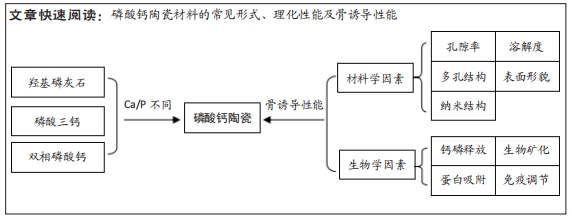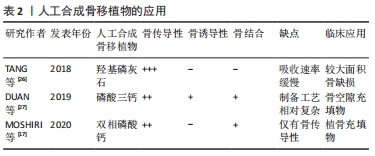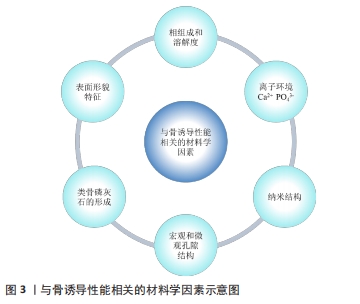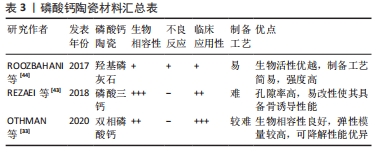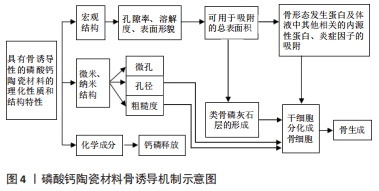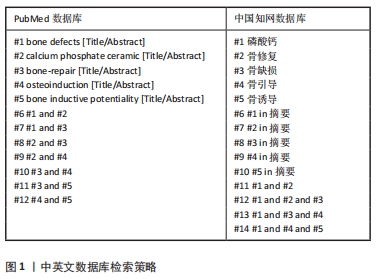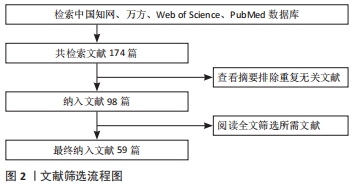[1] BOULER JM, PILET P, GAUTHIER O, et al. Biphasic calcium phosphate ceramics for bone reconstruction: A review of biological response. Acta Biomater. 2017;53:1-12.
[2] ZHANG D, ZONG X, GUO X, et al. Influence of different sintering temperatures on mesoporous structure and ectopic osteogenesis of biphasic calcium phosphate ceramic granule materials. Zhongguo Xiu Fu Chong Jian Wai Ke Za Zhi. 2021;35(1):95-103.
[3] HONG Y, FAN H, LI B, et al. Fabrication, biological effects, and medical applications of calcium phosphate nanoceramics. Mater Sci Eng R Rep. 2010;70(3-6):225-242.
[4] 刘日旭,吕文波,高文山.磷酸钙骨水泥改性相关研究与临床应用[J].中国组织工程研究,2021,25(34):5537-5543.
[5] XIAO D, ZHANG J, ZHANG C, et al. The role of calcium phosphate surface structure in osteogenesis and the mechanisms involved. Acta Biomater. 2020;106:22-33.
[6] 周育巧,郭阗廷,许强,等.羟基磷灰石在骨科中应用的研究进展[J].赣南医学院学报,2020,40(10):1068-1072.
[7] WU L, ZHOU C, ZHANG B, et al. Construction of Biomimetic Natural Wood Hierarchical Porous-Structure Bioceramic with Micro/Nanowhisker Coating to Modulate Cellular Behavior and Osteoinductive Activity. ACS Appl Mater Interfaces. 2020;12(43):48395-48407.
[8] 陈崧,何远丽,谢雯佳,等.磷酸钙纳米颗粒药物递送系统在骨组织工程研究与应用中的优势[J].中国组织工程研究,2021,25(22): 3565-3570.
[9] MATSUO A, CHIBA H, TAKAHASHI H, et al. Clinical application of a custom-made bioresorbable raw particulate hydroxyapatite/poly-L-lactide mesh tray for mandibular reconstruction. Odontology. 2010; 98(1):85-88.
[10] WANG J, CHEN X, GUO B, et al. A serum protein adsorption profile on BCP ceramics and influence of the elevated adsorption of adhesive proteins on the behaviour of MSCs. J Mater Chem B. 2018;6(45): 7383-7395.
[11] LI J, YUAN H, CHANDRAKAR A, et al. 3D porous Ti6Al4V-beta-tricalcium phosphate scaffolds directly fabricated by additive manufacturing. Acta Biomater. 2021;126:496-510.
[12] RH OWEN G, DARD M, LARJAVA H. Hydoxyapatite/beta-tricalcium phosphate biphasic ceramics as regenerative material for the repair of complex bone defects. J Biomed Mater Res B Appl Biomater. 2018; 106(6):2493-2512.
[13] SAMAVEDI S, WHITTINGTON AR, GOLDSTEIN AS. Calcium phosphate ceramics in bone tissue engineering: a review of properties and their influence on cell behavior. Acta Biomater. 2013;9(9):8037-8045.
[14] WANG M, CHEN F, WANG J, et al. Calcium phosphate altered the cytokine secretion of macrophages and influenced the homing of mesenchymal stem cells. J Mater Chem B. 2018;6(29):4765-4774.
[15] CHAI YC, CARLIER A, BOLANDER J, et al. Current views on calcium phosphate osteogenicity and the translation into effective bone regeneration strategies. Acta Biomater. 2012;8(11):3876-3887.
[16] SANTOS PS, CESTARI TM, PAULIN JB, et al. Osteoinductive porous biphasic calcium phosphate ceramic as an alternative to autogenous bone grafting in the treatment of mandibular bone critical-size defects. J Biomed Mater Res B Appl Biomater. 2018;106(4):1546-1557.
[17] MOSHIRI A, TEKYIEH MAROOF N, MOHAMMAD SHARIFI A. Role of organic and ceramic biomaterials on bone healing and regeneration: An experimental study with significant value in translational tissue engineering and regenerative medicine. Iran J Basic Med Sci. 2020; 23(11):1426-1438.
[18] 李祖浩,王辰宇,王中汉,等.骨质疏松性骨缺损的治疗进展:支架植入与局部药物递送[J].中国组织工程研究,2018,22(18):2939-2945.
[19] JEONG J, KIM JH, SHIM JH, et al. Bioactive calcium phosphate materials and applications in bone regeneration. Biomater Res. 2019;23:4.
[20] KIM SE, PARK K. Recent Advances of Biphasic Calcium Phosphate Bioceramics for Bone Tissue Regeneration. Adv Exp Med Biol. 2020; 1250:177-188.
[21] LEVINGSTONE TJ, HERBAJ S, DUNNE NJ. Calcium Phosphate Nanoparticles for Therapeutic Applications in Bone Regeneration. Nanomaterials (Basel). 2019;9(11):1570.
[22] RIPAMONTI U. Bone induction in nonhuman primates. An experimental study on the baboon. Clin Orthop Relat Res. 1991;(269):284-294.
[23] WANG J, CHEN Y, ZHU X, et al. Effect of phase composition on protein adsorption and osteoinduction of porous calcium phosphate ceramics in mice. J Biomed Mater Res A. 2014;102(12):4234-4243.
[24] CHEN Y, WANG J, ZHU X, et al. The directional migration and differentiation of mesenchymal stem cells toward vascular endothelial cells stimulated by biphasic calcium phosphate ceramic. Regen Biomater. 2018;5(3):129-139.
[25] DENRY I, KUHN LT. Design and characterization of calcium phosphate ceramic scaffolds for bone tissue engineering. Dent Mater. 2016;32(1): 43-53.
[26] TANG Z, LI X, TAN Y, et al. The material and biological characteristics of osteoinductive calcium phosphate ceramics. Regen Biomater. 2018; 5(1):43-59.
[27] DUAN R, VAN DIJK LA, BARBIERI D, et al. Accelerated bone formation by biphasic calcium phosphate with a novel sub-micron surface topography. Eur Cell Mater. 2019;37:60-73.
[28] 陈浩东,姚金凤,梁志刚.磷酸钙的固有骨诱导性及其应用[J].中国组织工程研究,2016,20(25):3785-3792.
[29] DIMITRIOU R, JONES E, MCGONAGLE D, et al. Bone regeneration: current concepts and future directions. BMC Med. 2011;9:66.
[30] GUO X, JIANG H, ZONG X, et al. The implication of the notch signaling pathway in biphasic calcium phosphate ceramic-induced ectopic bone formation: A preliminary experiment. J Biomed Mater Res A. 2020;108(5):1035-1044.
[31] CHEN F, WANG M, WANG J, et al. Effects of hydroxyapatite surface nano/micro-structure on osteoclast formation and activity. J Mater Chem B. 2019;7(47):7574-7587.
[32] LUO G, HUANG Y, GU F. rhBMP2-loaded calcium phosphate cements combined with allogenic bone marrow mesenchymal stem cells for bone formation. Biomed Pharmacother. 2017;92:536-543.
[33] OTHMAN Z, MOHREN RJC, CILLERO-PASTOR B, et al. Comparative proteomic analysis of human mesenchymal stromal cell behavior on calcium phosphate ceramics with different osteoinductive potential. Mater Today Bio. 2020;7:100066.
[34] CHEN Y, WANG J, ZHU XD, et al. Enhanced effect of β-tricalcium phosphate phase on neovascularization of porous calcium phosphate ceramics: in vitro and in vivo evidence. Acta Biomater. 2015;11:435-448.
[35] YAO J, LIU Z, MA W, et al. Three-Dimensional Coating of SF/PLGA Coaxial Nanofiber Membranes on Surfaces of Calcium Phosphate Cement for Enhanced Bone Regeneration. ACS Biomater Sci Eng. 2020;6(5):2970-2984.
[36] LI Y, JIANG T, ZHENG L, et al. Osteogenic differentiation of mesenchymal stem cells (MSCs) induced by three calcium phosphate ceramic (CaP) powders: A comparative study. Mater Sci Eng C Mater Biol Appl. 2017; 80:296-300.
[37] WANG Z, TANG Z, QING F, et al. Applications of calcium phosphate nanoparticles in porous hard tissue engineering scaffolds. NANO. 2012; 7(4):1230004.
[38] CHEN Y, SUN Z, LI Y, et al. Preparation and biological effects of apatite nanosheet-constructed porous ceramics. J Mater Chem B. 2017;5(4): 807-816.
[39] ZHANG C, ZHANG T, GENG T, et al. Dental Implants Loaded With Bioactive Agents Promote Osseointegration in Osteoporosis: A Review. Front Bioeng Biotechnol. 2021;9:591796.
[40] MCMURRAY RJ, GADEGAARD N, TSIMBOURI PM, et al. Nanoscale surfaces for the long-term maintenance of mesenchymal stem cell phenotype and multipotency. Nat Mater. 2011;10(8):637-644.
[41] ZAMPARINI F, PRATI C, GENERALI L, et al. Micro-Nano Surface Characterization and Bioactivity of a Calcium Phosphate-Incorporated Titanium Implant Surface. J Funct Biomater. 2021;12(1):3.
[42] WANG Z, XIAO Z, FAN H, et al. Fabrication of Micro-grooved Patterns on Hydroxyapatite Ceramics and Observation of Earlier Response of Osteoblasts to the Patterns. J Inorg Mater. 2013;28(1):51-57.
[43] REZAEI M, FARHADIAN M, RASHIDI AM, et al. Nano-Biphasic Calcium Phosphate Ceramic for the Repair of Bone Defects. J Craniofac Surg. 2018;29(6):e543-e548.
[44] ROOZBAHANI M, ALEHOSSEINI M, KHARAZIHA M, et al. Nano‑calcium phosphate bone cement based on Si-stabilized α-tricalcium phosphate with improved mechanical properties. Mater Sci Eng C Mater Biol Appl. 2017;81:532-541.
[45] LI B, CHEN X, GUO B, et al. Fabrication and cellular biocompatibility of porous carbonated biphasic calcium phosphate ceramics with a nanostructure. Acta Biomater. 2009;5(1):134-143.
[46] KANG HJ, MAKKAR P, PADALHIN AR, et al. Comparative study on biodegradation and biocompatibility of multichannel calcium phosphate based bone substitutes. Mater Sci Eng C Mater Biol Appl. 2020;110:110694.
[47] DOOSTI BA, LOBOVKINA T. Ca2+ Gradient Induces Membrane Bending and Formation of Nanotubes in Giant Lipid Vesicles. Biophys J. 2016; 110(3):584A.
[48] MURSHED M, HARMEY D, MILLÁN JL, et al. Unique coexpression in osteoblasts of broadly expressed genes accounts for the spatial restriction of ECM mineralization to bone. Genes Dev. 2005;19(9): 1093-1104.
[49] ZHU XD, ZHANG HJ, FAN HS, et al. Effect of phase composition and microstructure of calcium phosphate ceramic particles on protein adsorption. Acta Biomater. 2010;6(4):1536-1541.
[50] ZENG J, LIN J, YAO G, et al. Effect of modified compound calcium phosphate cement on the differentiation and osteogenesis of bone mesenchymal stem cells. J Orthop Surg Res. 2017;12(1):102.
[51] CHEN X, WANG J, CHEN Y, et al. Roles of calcium phosphate-mediated integrin expression and MAPK signaling pathways in the osteoblastic differentiation of mesenchymal stem cells. J Mater Chem B. 2016;4(13): 2280-2289.
[52] SHEKARAN A, GARCÍA AJ. Extracellular matrix-mimetic adhesive biomaterials for bone repair. J Biomed Mater Res A. 2011;96(1):261-272.
[53] SALASZNYK RM, KLEES RF, WILLIAMS WA, et al. Focal adhesion kinase signaling pathways regulate the osteogenic differentiation of human mesenchymal stem cells. Exp Cell Res. 2007;313(1):22-37.
[54] LU Z, ZREIQAT H. The osteoconductivity of biomaterials is regulated by bone morphogenetic protein 2 autocrine loop involving α2β1 integrin and mitogen-activated protein kinase/extracellular related kinase signaling pathways. Tissue Eng Part A. 2010;16(10):3075-3084.
[55] MILLAN C, VIVANCO JF, BENJUMEDA-WIJNHOVEN IM, et al. Mesenchymal Stem Cells and Calcium Phosphate Bioceramics: Implications in Periodontal Bone Regeneration. Adv Exp Med Biol. 2018;1107:91-112.
[56] DE MELO PEREIRA D, EISCHEN-LOGES M, BIRGANI ZT, et al. Proliferation and Osteogenic Differentiation of hMSCs on Biomineralized Collagen. Front Bioeng Biotechnol. 2020;8:554565.
[57] HUMBERT P, BRENNAN MÁ, DAVISON N, et al. Immune Modulation by Transplanted Calcium Phosphate Biomaterials and Human Mesenchymal Stromal Cells in Bone Regeneration. Front Immunol. 2019;10:663.
[58] CHEN X, WANG M, CHEN F, et al. Correlations between macrophage polarization and osteoinduction of porous calcium phosphate ceramics. Acta Biomater. 2020;103:318-332.
[59] WANG J, CHEN X, YANG X, et al. Positive role of calcium phosphate ceramics regulated inflammation in the osteogenic differentiation of mesenchymal stem cells. J Biomed Mater Res A. 2020;108(6):1305-1320.
|
